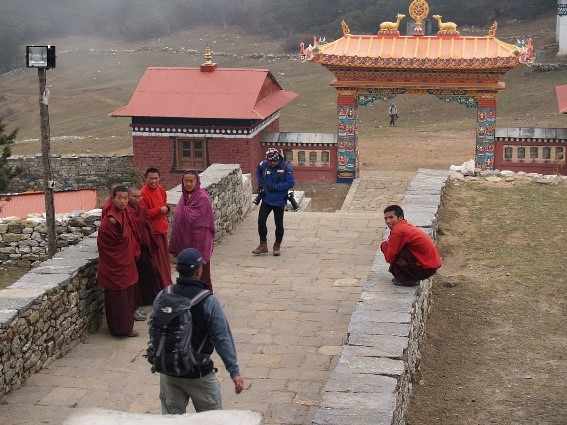Item Code: 161/np-7
Year
|
2007
|
Obverse
|
Mount Everest (Chomolungma); Devas Indra;
Himalaya mountain peaks; Thyangboche (Tengboche) monastery; Coin.
|
Reverse
|
Himalayan Tigers;
Coat of arms; Bank logo.
|
Size
|
161 x 70 mm
|
Obverse description
Tengboche Monastery
 |
Tengboche
Monastery
|
Tengboche
Monastery (or Thyangboche Monastery), also known as Dawa Choling Gompa, in the Tengboche village in Khumjung in the Khumbu region of eastern Nepal is a Tibetan Buddhist
monastery of
the Sherpa community. Situated at 3,867 metres (12,687 ft), the monastery is the largest gompa in
the Khumbu region of Nepal. It was
built in 1916 by Lama Gulu with strong links to its mother monastery known as
the Rongbuk Monastery in Tibet. In 1934, it was destroyed by an earthquake and was
subsequently rebuilt. In 1989, it was destroyed for a second time by a fire and
then rebuilt with the help of volunteers and international assistance.
 |
A statue at the entrance
|
Tengboche
monastery is amidst the Sagarmatha National Park (a UNESCO
World Heritage Site of
"outstanding universal value”), draped with a panoramic view of the Himalayan Mountains, including the well-known peaks of Tawache, Everest, Nuptse, Lhotse, Ama Dablam,
and Thamserku.
 |
Entrance
to the monastery
|
Tengboche
is the terminus site of the
"Sacred Sites Trail Project" of the Sagarmatha National Park that attracts large number of tourists for trekking and
mountaineering. It is a circular trail that covers 10 monasteries in a
clockwise direction terminating in the Tengboche Monastery.
 |
A
restored painting in the monastery
|
 |
Painting and mural inside the
monastery
|
Reverse description
Bengal Tigers in Nepal
Bengal tigers number around
163–253 in Nepal. The
tiger population in the Terai of
Nepal is split into three isolated
subpopulations that are separated by cultivation and densely settled habitat.
The largest population lives in Chitwan National Park and in the
adjacent Parsa Wildlife Reserve encompassing
an area of 2,543 km2 (982 sq mi) of prime lowland forest.
To the west, the Chitwan population is
isolated from the one in Bardia National Park and adjacent
unprotected habitat farther west, extending to within 15 km (9.3 mi)
of the Shuklaphanta Wildlife Reserve,
which harbours the smallest population. The bottleneck between the Chitwan-Parsa and Bardia-Sukla
Phanta metapopulations is situated just north of the town of Butwal.
As
of 2009, an estimated 121 breeding tigers lived
in Nepal. By 2010, the number of adult tigers had reached 155. A survey conducted from
December 2009 to March 2010 indicates that 125 adult tigers
live in Chitwan National Park and its
border areas covering 1,261 km2 (487 sq mi). From
February to June 2013, a camera trapping survey was carried out in the Terai Arc Landscape, covering an area of
4,841 km2 (1,869 sq mi) in 14 districts. The country's tiger population was estimated at 163–235 breeding
adults comprising 102–152 tigers in the Chitwan-Parsa protected areas, 48–62 in the Bardia-Banke National Parks and 13–21 in the Shuklaphanta Wildlife Reserve.
 |
Distribution of panthera
tigris tigris
|
Poaching: The
most significant immediate threat to the existence of wild tiger populations is the illegal trade in poached
skins and body parts between India, Nepal and China.
The governments of these countries have failed to implement adequate
enforcement response, and wildlife crime remained a low priority in terms of
political commitment and investment for years. There are well-organised gangs
of professional poachers, who move from place to place and set up camp in
vulnerable areas. Skins are rough-cured in the field and handed over to
dealers, who send them for further treatment to Indian tanning centres.
Buyers choose the skins from dealers or tanneries and smuggle them through a
complex interlinking network to markets outside India,
mainly in China. Other factors contributing to
their loss are urbanization and revenge killing. Farmers blame tigers for killing cattle and shoot them. Their skins
and body parts may however become a part of the illegal trade.
Human–tiger conflict:
In
Nepal, the incidence of man-eating tigers has been only sporadic. In Chitwan National Park no cases were recorded
before 1980. In the following few years, 13 people have been killed and eaten
in the park and its environs. In the majority of cases, man-eating appeared to
have been related to an intra-specific competition among male tigers.
Conservation efforts: An
area of special interest lies in the Terai Arc
Landscape in the Himalayan foothills of northern India and southern
Nepal, where 11 protected areas composed of dry forest
foothills and tall-grass savannas harbor tigers in
a 49,000 square kilometres (19,000 sq mi) landscape. The goals are to
manage tigers as a single metapopulation, the dispersal of which between
core refuges can help maintain genetic, demographic, and ecological integrity,
and to ensure that species and habitat conservation becomes
mainstreamed into the rural development agenda. In Nepal
a community-based tourism model has been developed with a strong
emphasis on sharing benefits with local people and on the regeneration of
degraded forests. The approach has been successful in reducing poaching,
restoring habitats, and creating a local constituency for conservation. The
government aims at doubling the country's tiger population
by 2022, and in May 2010, decided to establish Banke National Park with a
protected area of 550 square kilometres (210 sq mi), which bears good
potential for tiger habitat. It
is protected in Chitwan National Park, Bardiya National Park, Sukla Phanta Wildlife Reserve, etc.…




No comments:
Post a Comment